Foreword
Almost a year ago I was talking about writing about Majapahit and Gajah Mada, but until now, I couldn’t find the time. Why do I wanna write about Majapahit? Well, for starter, I’ve done quite a research on it for a script for my club’s play, so I feel it such a waste if I don’t record it elsewhere. I actually did a paper for that research (mortifying huh, and no one’s grading it, so unlike me =p), but it’s in Indonesian since my research were in Indonesian, felt it easier to write in Indo when I’ve the information in Indonesian.
However, I realized from my online search that not much information can be gotten regarding the fuller history of Majapahit – this great kingdom – especially information in English. So I just want to share what I got here so the world can know about this great ancient kingdom in Indonesia (and pardon my less than perfect English =p – I’m translating this from the report in Indonesian that I did).
And I just want to say that this is simply a collation of the research that I did. I can’t remember the online sources or other book sources, but the few that I do remember and I’ve taken a great amount of information from, I mentioned here. So don’t accuse me of plagiarism =p. Annddd.. please don’t think of me as an expert on Majapahit. I just researched briefly for about a week, and I know nothing else.
And I would like to thank my brothers and parents for this. My brothers for accompanying me to National Museum (while grumbling all the way through – but it was good education, right? =p) and even to the library. My parents for letting me use the car for a few whole days. And thanks to my friends in the GY@ committee because I made this for them, and without that pressure, I wouldn’t spend a week of my holiday doing this research =p. (Gosh, I feel like I’m writing a real book =p).
Lastly, I hope that whatever in this paper can help you in gaining better understanding of Majapahit.
Singapore,
Friday, 22 February 2008, 2:08PM,
-me-
Introduction
Majapahit is the last great Hindu empire in Indonesia. Its era ended in the 15th century. However, in the two centuries that it existed, it had made a huge impact to Indonesia. Its kingdom covered a vast area, even covering Malaya and the Philippines. Its most renowned Prime Minister, Gajah Mada, made the famous oath, Sumpah Palapa (Palapa Oath), to conquer the neighboring kingdoms and unite them all under Majapahit, creating a Nusantara. The oath and the vision of Nusantara were what the modern Indonesian youths held to when they came together and came up with Sumpah Pemuda in 1928, the oath to be under one nation, one people, and one language – the nation that would be known as Indonesia.
This paper is a documentation (or report) on the research that was done on Majapahit, both its history and culture for the purposes of my club’s musical production, GY08, Gajah Mada. The content of this report were derived from various sources, both electronic and print, and including the visit to Majapahit Exhibition at Museum Nasional, Jakarta. Since the research done was not massive, this report is not exhaustive and may contain errors.
Caution must be taken when reading this report. Because information gotten regarding Majapahit can be confusing and uncertain, there are many personal interpretations made when writing this report. Various versions or theories regarding the history and culture of Majapahit are presented so that readers can make their own interpretations and analysis. I also include my own analysis, which may or may not be true.
1. History
1.1. Sources
The history presented here is a history taken from variety of sources, like the Internet, research books, history novels, and National Museum in Jakarta. The biggest sources were the book by Prof. Dr. Slamet Muljana titled Runtuhnya Kerajaan Hindu-Jawa dan Timbulnya Negara-Negara Islam di Nusantara (“The Fall of Hindu-Javanese Empires and the Rise of Islamic Nations in Nusantara”) and the fictional series Gajah Mada by Langit Kresna Hariadi.
The sources themselves were based from old texts, such as Negarakertagama, Pararaton, Babad Tanah Jawi, Serat Kanda, and prasasti (stone monolith carving). Often these old texts contradict each other. If that happens, the more trustworthy source would be Negarakertagama. Other sources are more of folk legends passed down by word of mouth, in which the accuracy and reliability are much more questioned. Babad Tanah Jawi, for example, existed at the beginning of the 18th century, the era where Indonesia was colonized by the Dutch. This babad is a result of reconstruction by the people to remember the glorious past, and as such, the story sounds more like a legend albeit the fact that it carries some historical facts. Negarakertagama itself was penned down by Prapanca, who wrote it under the command of Gajah Mada. As such, it is likely that Negarakertagama does not give an objective view of Gajah Mada, and other sources should be taken into account. For example, it is wiser not to rely on Negarakertagama alone to know more about Perang Bubat (Bubat War – the war between Majapahit and the Sunda kingdom) and the fall of Gajah Mada, but it is better to look at other sources such as Pararaton and Kidung Sundayana that can present the Sundanese’s side of the story.
Other different versions of the history of Majapahit will be presented here in this report because often when history is unclear and uncertain, we have to use our own interpretations to choose which story we want to think as right.
1.2. Genealogy
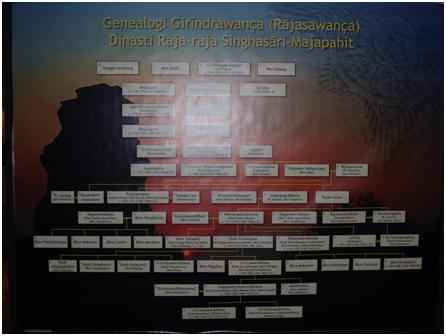
Figure 1.1. Poster of genealogy of the kings/queens of Majapahit, taken in the National Museum in Jakarta (enlarge to see)
1.3. Names of the People in History
The people in the history of Majapahit often have more than one name. Besides their real names, or child names, they were often given royal names, or abhisekanama, when they became raja (king) or rani (queen) or an official (such as when they were appointed to rule a district). The names used in this report are the names that are popular among the public (unfortunately, the types of names used are often inconsistent; some characters are more known by their child names while others are known by their abhisekanama).
The following are the names of the characters in the Majapahit history:
Singosari Kingdom
Kertanegara (the last king)
Majapahit Kingdom
|
Child Name |
Abhisekanama |
Other title |
|
Raden Wijaya |
Kertarajasa Jayawardhana |
Brawijaya (in Babad) |
|
Raden Kala Gemet |
Jayanegara |
|
|
Rajapatni |
Gayatri |
|
|
Sri Gitarja |
Tribuwanatunggadewi |
Bhre Kahuripan |
|
Dyah Wiyat |
Rajadewi Maharajasa |
Bhre Daha |
|
Hayam Wuruk |
Rajasanegara |
|
|
Gajah Mada |
|
|
Pasundan Sunda Kingdom
Maharaja Linggabuana (king)
Dewi Lara Linsing (king’s wife)
Dyah Pitaloka Citrasemi (king’s daughter)
1.4. Raja/Rani (King/Queen) of Majapahit
Notes: For easy reading, the year used is based on the modern calendar instead of the Saka calendar that was used at the time. Saka year is 78 years earlier than the modern year. For example, Raden Wijaya took the throne on Saka Year 1216, which is the modern year 1294.
1. Kertarajasa Jayawardhana (Raden Wijaya) 1294 – 1309
2. Jayanegara (Kala Gemet) 1309 – 1328
3. Tribuwanatunggadewi (Jayawisnuwardhani) 1328 – 1350
4. Rajasanegara (Hayam Wuruk) 1350 – 1389
5. Wikrawardhana (Hyang Wisesa; husband of Kusumawardhani) 1389 – 1427
6. Suhita 1427 – 1451
7. bhre Daha (inbetween Suhita’s reign) 1437 –
8. Sri Kertawijaya 1447 – 1451
9. Others
Two of the last rulers of Majapahit were appointed by Demak Kingdom – and Islamic kingdom. Hence, Majapahit, nearing its end, was under the rule of Demak. It was said that one of the last rulers of Majapahit was a Chinese.
1.5. Maha Patih (Prime Minister) of Majapahit
Note: The mention of the names of patih (minister) in history was only until the ruling of Wikramawardhana (husband of Kusumawardhani).
1. Nambi 1294 – 1316
2. Halayuda 1316 – 1323
3. Arya Tadah 1323 – 1334
4. Gajah Mada 1334 – 1364
No maha patih for 3 years
5. Gajah Enggon 1367 – 1394
6. Gajah Manguri 1394 – 1398
7. Gajah Lembana 1398 – 1410
8. Tuan Tanaka 1410 – 1430
1.6. History of Majapahit
The history of Majapahit was taken from several sources. Including in this research is also writer’s own interpretation and analysis.
1.6.1. The Beginning of Majapahit
Singosari Kingdom began its history with the famous story of Ken Arok, a small villain who betrayed and killed the King of Tumapel – Tunggul Ametung – with a cursed keris (traditional knife), took the wife of Tunggul Ametung – Ken Dedes –, defeated king of Kediri – Kertajaya –, and finally built the kingdom of Singosari. However, the story of Ken Arok was filled with tragedy after tragedy that was said to have been caused by the keris cursed by its maker, Mpu Gandring. Mpu Gandring himself was said to have been killed by Ken Arok out of impatience as he had wanted to have the keris much earlier than allowed by Mpu Gandring.
During the reign of Kertanegara, the last king of Singosari, the Mongol Empire sent an emissary to command Singosari to bow down to Mongol. This caused the anger of Kertanegara and the emissary was killed. Kertanegara then prepared his army to face Mongol. However, during this time, Jayakatwang rebelled and killed Kertanegara.
Raden Wijaya was the son-in-law of Kertanegara, and also the descendant of Mahesa Cempaka. Mahesa Cempaka assisted in the rebellion of Ranggawuni, son of Anusapati, against Tohjaya (son of Ken Arok and his second wife, Ken Umang; he killed Anusapati, son of Tunggul Ametung and Ken Dedes). Mahesa Cempaka was the descendant of Ken Arok and Ken Dedes. As such, Raden Wijaya was also the descendant of Ken Arok.
Raden Wijaya took revenge on Jayakatwang by manipulating the Tartar army to help him defeat Jayakatwang. Afterwards, Raden Wijaya turned against the Tartar from Mongol and drove them away from Java.
Raden Wijaya and his band of people then built a new kingdom, Wilwatikta, or better known as Majapahit. The name Majapahit itself originated from a bitter fruit of maja (bitter = ‘pahit’) that was found by Raden Wijaya’s army as they were opening the Trik forest (estimated to be in the area of Tarik, Sidoarjo) and felt hungry.
1.6.2. The Glory of Majapahit
Prof. Dr. Slamet Muljana said, “At the essence, the glorious history of Majapahit is the story of the life of Maha Patih Gajah Mada.” The glory of Majapahit dissipated after the reign of Hayam Wuruk. Hence, this part of the history of Majapahit revolves around the reign of Jayanegara, where Gajah Mada gained prominence, to the reign of Hayam Wuruk.
Jayanegara
Raden Wijaya married the four daughters of Kertanegara. The wives are Tribhuaneswari, Narendraduhita, Pradnya Paramita, and Dya Dewi Gayatri. The most known among them is Rajapatni Gayatri, who had two daughters, Sri Gitarja (or Tribuwanatunggadewi) who became bhre Kahuripan (ruler of Kahuripan district) and Dyah Wiyat (or Rajadewi Maharajasa) who became bhre Daha (ruler of Daha district).
A source said that there was a historic prophecy that said that the kings of Java shall come from Gayatri. However the reality was Raden Wijaya appointed Jayanegara as his heir, who though was the only son of Raden Wijaya but was not the son of Raden Wijaya’s first queen. Jayanegara himself had a child name of Kala Gemet, which means “weak villain.” Jayanegara took the throne with the name Abhiseka Wiralandagopala in the year AD 1309.
Jayanegara was the son of Putri Negeri Seberang (Princess from the Country Across the Sea) who came from the Malay-Jambi Kingdom, Dharmasraya, in Sawahlunto. It was said that when the army of Raden Wijaya went to Negeri Seberang (either for colonization or mere visit), they brought home precious goods and two sister princesses, who were Dara Jingga and Dara Petak. Dara Jingga was married to a high official of Majapahit. Their son, Adityawarman, was Majapahit general and who was also to become King of Melayu (which seems to be under the ruling of Majapahit too).
Dara Petak herself was married by Raden Wijaya. In Majapahit, Dara Petak was known by the name Indreswari. Dara Petak bore Raden Wijaya a son, Raden Kala Gemet. Perhaps because she was the only wives of Raden Wijaya to bear him son, Dara Petak was made Sthri Tinuheng Pura, which means “wife that was made senior in pura (palace)”, or in the other words, she was made the Queen of the palace, although she was actually the fifth wife of Raden Wijaya.
When Jayanegara ruled, Gajah Mada was only a bekel, which is a low-ranked soldier under a senopati. However, he had been entrusted with leading the Bhayangkara squad, which was the last line of defense in protecting the royal family. During his reign, Jayanegara faced several rebellions, but the most famous one was the rebellion by Rakrian Kuti, which took place in Saka Year 1241 or AD 1319; this event was also one that soared Gajah Mada’s name.
The following was the information gotten from the novel Gajah Mada by Langit Kresna Hariadi. Though this is a history novel and has a lot of fiction, it has reliable information that was based on historic facts or Langit’s own research.
It was said that a king granted Anugerah Winehsuka to those who had high loyalty and service to the king. These people were called Rakrian Dharmaputra Winehsuka. In the novel Gajah Mada, it was said that during Jayanegara’s reign, there were several rakrian, which were Ra Kuti, Ra Tanca, Ra Pangsa, Ra Banyak, Ra Wedeng, Ra Yuyu, and Ra Semi. There were also three main squads, which were Jalapati, Jalayuda, and Jala Rananggara; however, none of the rakrians had authority over these main squads.
When Ra Kuti rebelled, Gajah Mada took the royal family to safety to Rimbi, the place where Gayatri who had become a Buddhist nun resided. Jayanegara himself fled to Bedander. Gajah Mada spread a rumor that Jayanegara had died. This, in addition to the ruthless ruling of Kuti, made the people unhappy. The throne was soon regained back by Jayanegara. Ra Kuti was killed during the rebellion. Gajah Mada, due to his great contribution, was made Patih Kahuripan or Minister of Kahuripan (later he would become Patih Kediri, and finally Maha Patih or Prime Minister). It is interesting to note that Tribuwanatunggadewi who would later become rani or queen of Majapahit was once a bhre Kahuripan.
It was said that Ra Tanca joined in the rebellion, but was forgiven. Nine years after the rebellion, Jayanegara suffered a serious boil. Ra Tanca, who was a skillful physician and a poison expert, was called to treat the king. Ra Tanca used that chance to kill Jayanegara (either by poison or by blade). Gajah Mada then killed Ra Tanca by stabbing him.
There were several theories regarding the assassination of Jayanegara. One version told that Ra Tanca murdered Jayanegara on his own initiative, either to avenge his friends who died during the rebellion, or, according to another version, to take revenge on Jayanegara for seducing Ra Tanca’s wife.
Another version said that it was Gajah Mada who ordered Ra Tanca to kill Jayanegara. One version mentioned of Gajah Mada giving that order because Jayanegara was an immoral king who wanted to marry his half-sisters, which were Sri Gitarja and Dyah Wiyat. Another legend said that Gajah Mada was vengeful because Jayanegara took Gajah Mada’s wife; this version, however, is very doubtful because there is no strong evidence, especially because it was believed that Gajah Mada had no wife.
Another theory was Jayanegara was killed to return the throne of Majapahit to the descendants of Kertanegara because the oracle was that the descendants of kings of Java shall come from Gayatri, which sadly only had daughters. Because Jayanegara had no son when he died, the throne would fall back to the descendants of Kertanegara because Gayatri then would sit on the throne.
Jayanegara was a mixed-blood son, a mix of Java and Malay (or Negeri Seberang). As such, it might be the case that the royal family did not like this. There was also a rumor that Jayanegara did not want any man to marry his half-sisters so that their husbands would not be able to claim the throne. However, this theory had never been confirmed.
Negarakertagama itself wrote a lot about Rajapatni Gayatri and portrayed her as a wise Empress Dowager. Because Negarakertagama was written under the command of Gajah Mada, it is plausible that Gajah Mada had a good relation with the Empress Dowager. As such, there is a possibility that Gajah Mada supported the descendant of Gayatri to claim the throne. However, no theory can confirm the role of Gajah Mada in the assassination of Jayanegara.
Langit Kresna Hariadi himself, in his novel Gajah Mada, theorized that Ra Tanca fell in love with Dyah Wiyat. When Jayanegara came to know about this, he mocked Ra Tanca because of his lower status than the king’s half-sister. Because of that, Ra Tanca took revenge on Jayanegara. However, whether Langit got this idea from historical facts or even legends such as Babad Tanah Jawi is unknown.
In the end, it seems which theory or version of history that one wants to believe in would depend on one’s own interpretation and analysis.
Tribuwanatunggadewi
Jayanegara left no heir to rule Majapahit after him. Rightfully, the throne falls to the hands of his stepmother, Gayatri. However, at that time Gayatri had become a Buddhist nun and apparently was not interested in ruling on the throne. As such, it had to be decided on who was to rule in the place of Gayatri, was it her daughters, Sri Gitarja or Dyah Wiyat? It was said that after the death of Jayanegara, the throne was empty for about a year.
Finally, on Gajah Mada’s suggestion, Gayatri appointed both of her daughters to be rani kembar (twin queens). However, the queen that was more prominent (and apparently had more power) was Tribuwanatunggadewi. This bhre Kahuripan took the throne with abhiseka name of Jayawisnuwardhani. It is interesting to note that Gajah Mada’s suggestion who was only a patih at that time had a huge impact on determining the next ruler of Majapahit.
Tribuwanatunggadewi married Kertawardana (bhre Tumapel, whose real name was Cakradara) and Rajadewi married Wijayarajasa (bhre Wengker, whose real name was Kudamerta). Tribuwanatunggadewi bore Hayam Wuruk in the Saka Year 1256.
In AD 1320, Maha Patih Arya Tada appointed Gajah Mada to replace him as Maha Patih. However, Gajah Mada rejected the idea, saying that he would only become a Maha Patih after he defeated Keta and Sadeng who rebelled against Majapahit. After defeating Keta and Sedang, Gajah Mada became Maha Patih in AD 1334.
When he was appointed as Maha Patih, Gajah Mada said his famous oath, which is Nusantara Oath or Palapa Oath (Sumpah Palapa) on the Saka Year 1256 or AD 1336, which was said in front of the rani of Majapahit.
Palapa Oath that was declared by Gajah Mada as written in Pararaton is as follows:
“Sira Gajah Mada pepatih amungkubumi tan ayun amukti palapa, sira Gajah Mada: Lamun huwus kalah nusantara ingsun amukti palapa, lamun kalah ring Gurun, ring Seram, Tanjungpura, ring Haru, ring Pahang, Dompo, ring Bali, Sunda, Palembang, Tumasik, saman ingsun amukti palapa.”
The translation is:
“Gajah Mada the Maha Patih will not enjoy palapa, said Gajah Mada: As long as I have not united nusantara, I will not taste enjoy palapa. Before I conquered Gurun Island (Lombok), Seram Island, Tanjungpura (Kalimantan), Haru Island (North Sumatera), Pahang Island (Malaya), Dompo, Bali Island, Sunda, Palembang, and Tumasik (Singapore), I will not enjoy palapa.”
Palapa is a spice; hence, the Palapa Oath can be interpreted as Gajah Mada not tasting any spice until he fulfilled his oath. Although spice was precious then, spice also represented the pleasure of life. Hence, the Palapa Oath may also be Gajah Mada’s oath for not enjoying the pleasures of life and work incessantly for the unification of Nusantara.
It was said that the Palapa Oath of Gajah Mada brought mocking and objection from several high officials and ministers of Majapahit, and caused conflict between Gajah Mada and these people.
The period of AD 1294 (the beginning of Raden Wijaya’s reign) until AD 1336 (the reign of Tribuwanatunggadewi) was the period of consolidation of Majapahit rule to get back vassal countries that were part of Singosari but did not want to acknowledge Majapahit as the succesor of Singosari. After the consolidation, Majapahit then started to look outside to expand its boundaries. During this time was when Gajah Mada endeavored to fulfill his Oath.
Rajasanegara (Hayam Wuruk)
It is not clear when exactly Hayam Wuruk, son of Tribuwanatunggadewi, took the throne. However, it is estimated to happen in AD 1350. Hayam Wuruk took the throne at a very young age with Abhiseka name of Rajasanegara.
History notes that the golden age of Majapahit was during the reign of Hayam Wuruk. It was during this time too that Gajah Mada aggressively conquered various kingdoms around Majapahit. According to Negarakertagama, Sumatera regions that had submitted to Majapahit included Jambi, Palembang, Toba, Minangkabau, Lampung, etc.
During the rule of Hayam Wuruk, there happened a famous tragedy, the Bubat War. Pararaton noted that in Saka Year 1279 or AD 1357, Bubat War happened between Majapahit and the Kingdom of Sunda Pasundan.
The tragedy of Bubat War began with the desire of Hayam Wuruk to wed Sunda Princess, Dyah Pitaloka Citrasemi. Legend said it that Hayam Wuruk saw the picture of Dyah Pitaloka that was painted by Sungging Prabangkara. Other legend said that Hayam Wuruk who had no wife was looking for one that could be respected and loved by the people, and he heard that the beautiful Sundanese Princess had those characteristics.
Hayam Wuruk then sent a messenger to Sunda-Galuh to propose Dyah Pitaloka, in which this proposal was accepted by the Sundanese royal family. Hayam Wuruk himself was said to have Sundanese blood. Hence, it was expected that this marriage can make the Sunda Kingdom and Majapahit closer.
At that time, it was customary for the groom to go to the bride. However, at that time Hayam Wuruk asked Dyah Pitaloka to come to Majapahit instead. This was objected by several royal family members of Sunda as well as its Maha Patih, Hyang Bunisora Suradipati. However, the king, Maharaja Linggabuana, finally decided to bring Dyah Pitaloka to Majapahit. They went together with the Queen, Dewi Lara Linsing, and a small group of Balapati squad the royal army and several high officials and ministers of the kingdom. Their number was less than 100.
When the Sunda party arrived at the designated place in Bubat district, which was located just north of Majapahit capital of Trowulan, they found that they were not welcomed as expected.
According to Pararaton, Gajah Mada did not want an official wedding between Dyah Pitaloka and Hayam Wuruk, and demanded that Linggabuana give his daughter as a tribute and sign of submission of Sunda Kingdom to Majapahit; this would fulfill the Palapa Oath that was declared by Gajah Mada.
Of course Linggabuana became enraged and exchanges of insults took place, which led to a war between the bridal party from the Sunda Kingdom and Gajah Mada’s army. This war was not really fair because the Sundanese army had only less than 100 people and Gajah Mada’s army itself was more than 1,000 people. In the end the bridal party all died, including the king Linggabuana and his daughter, Dyah Pitaloka.
There were several theories regarding the death of Dyah Pitaloka. A source said that Dyah Pitaloka also joined in the war and managed to wound Gajah Mada with a kujang (a type of blade), and the wound that was suffered by Gajah Mada eventually led him to his death. However, the time difference between Bubat War and the death of Gajah Mada was quite long, which was around seven years; hence, it is unlikely that the wound caused by Dyah Pitaloka could cause the death of Gajah Mada. Besides, it was customary for princesses to bring cundrit or patrem, a small blade, and not keris to fight. Another theory said that Dyah Pitaloka, together with her mother and her maids, performed bela pati, which is a ritual whereby honor is paid by one’s life. They did suicide. One thing for sure, Dyah Pitaloka died in Bubat War.
There were also several theories regarding the cause of Bubat War. Pararaton said that the ambition of Gajah Mada to conquer nusantara was the cause. Another source said that there was a misunderstanding by Gajah Mada regarding the purpose of the arrival of the Sundanese Princess, which caused anger among the Sundanese party.
Hayam Wuruk who came to know about this war quite late regretted deeply the deaths of the bridal party. He sent an emissary from Bali, who was at Majapahit to witness the wedding between Hayam Wuruk and Dyah Pitaloka, to the Sunda Kingdom to ask for forgiveness from Maha Patih Hyang Bunisora Suradipati, who at that time became temporary official in Sunda Kingdom.
It was said that Bubat War caused the relationship between Gajah Mada and Hayam Wuruk soured, and Gajah Mada was eventually demoted. A source said that because of the Bubat War, Hayam Wuruk fell sick, in which this caused the anger of the royal family who blamed Gajah Mada, and Gajah Mada ran then ran away.
According to Negarakertagama itself, Hayam Wuruk still respect Gajah Mada and bestowed him Madakaripura village in Probolinggo. Some said that actually, Gajah Mada was demoted from his position as Maha Patih after Bubat War, but in the year of 1359 was promoted again as Patih of Madakaripura.
Gajah Mada died in the year of 1364, witnessed by Prapanca. After his death, the position of Maha Patih remained empty for three years. It was said that due to the big role of Gajah Mada as Maha Patih, it was difficult for Hayam Wuruk to find a replacement that he had to appoint six Patih to do Gajah Mada’s previous duties.
Negarakertagama by Prapanca itself stopped its story in the reign of Hayam Wuruk, which is in the year of 1365. It is predicted that Majapahit suffered a decline. It seems that after Gajah Mada, the glory of Majapahit declined, and declined much further after the death of Hayam Wuruk. Hayam Wuruk died in the Saka Year of 1311 or AD 1389.
1.6.3. The Fall of Majapahit
Failed to marry Dyah Pitaloka from Sunda, Hayam Wuruk married daughter of Bhra Parameswara, Paduka Sori. From her was born a daughter, Kusumawardhani, who became bhre Lasem. Actually, Hayam Wuruk had a son from his concubine, which was bhre Wirabhumi. However, because he was only son of a concubine, Wirabhumi could not become a king. This was the root of the conflicts within the royal family.
Kusumawardhani married Wikramawardhana, head of the high court of Majapahit and was still cousin of Kusumawardhani. When Hayam Wuruk died in the AD 1389, 25 years after Gajah Mada’s death, Wikramawardhana took the throne because he was the husband of the crown princess. This caused discontentment among the family side of Wirabhumi who felt that the throne of Majapahit was Wirabhumi’s right. In the year of 1401, Paregreg War took place, which was the war between bhre Wirabhumi and Wikramawardhana. This war was eventually won by Wikramawardhana.
It is interesting to note that the one who took the throne was not Kusumawardhani as a rani but her husband, Wikramawardhana. This is different from what happened when Jayanegara died. When Jayanegara died, Tribuwanatunggadewi and Rajadewi Maharajasa took the throne as rani kembar, and not their husbands. This Paregreg War was actually the root of the fall of Majapahit because after Hayam Wuruk, there occurred many civil wars and rebellions.
A theory that could be derived from Paregreg War was regarding the significant role of Gajah Mada in preserving the stability of Majapahit. Considering that Jayanegara died without an heir, Gajah Mada who was then only a patih suggested that the princesses take the throne. This perhaps shows that it should not be a problem for a woman to be a ruler and Gajah Mada might very well be a feminist. However, this theory should be scrutinized much further because Tribuwanatunggadewi ruled only briefly and was soon replaced by his son. Besides, it is likely that Gajah Mada had other reasons to suggest a rani kembar ruling. Perhaps if Gajah Mada were still alive, he would give wise suggestions regarding the successor of Hayam Wuruk.
Kusumawardhani and Wikramawardhana only had a daughter, Dewi Suhita. Dewi Suhita took the throne replacing Wikramawardhana in 1427. She ruled until 1447. Dewi Suhita and her husband, Hyang Parameswara, did not have a child. Some said that Dewi Suhita was not the daughter of Kusumawardhani but the child of Wikramawardhana from his concubine. However, this version was not popular and perhaps was not true.
Wikramawardhana also had sons from his concubines; they were bhre Tumapel and Sri Kertawijaya. When Dewi Suhita died without leaving an heir, her step brother, Sri Kertawijaya, took the throne. Sri Kertawijaya was the first ruler of Majapahit who was not the descendant of Raden Wijaya. Since then, the throne was a matter of disputes by various kings from various families who were not direct descendants of Raden Wijaya. During this period, the power and glory of Majapahit were rapidly declining.
After the Saka year 1400 or AD 1478, Majapahit fell into the hands of the Islamic Kingdom of Demak, and became a vassal state of Demak. The two last rulers of Majapahit were appointed by Demak. After several rebellions, Majapahit was finally destroyed by Demak. With the end of Majapahit Kingdom, so ended the era of Hindu kingdoms and was replaced with the era of the Islamic kingdoms.
2. Name, Symbol & Writing
2.1. Name
Majapahit = bitter (pahit) maja fruit.

Figure 2.1. Maja tree
However, prasasti (monoliths) found regarding Majapahit called Majaphit as “Wilwatikta”. Perhaps this is the official name of Majapahit.
2.2. Symbol
It was said that the symbol of Rakrian Tanca, the assassinator of Jayanegara, was maja fruit entangled by a snake, perhaps because Ra Tanca was not only a physician but a poison expert as well.
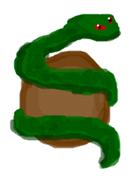
Figure 2.2. Symbol of Ra Tanca (made-up)
There was a relief that was often found in the ruins of Majapahit. That relief is the carving often called Surya Majapahit (Sun of Majapahit), where the relief shows a character, who was thought to be the Sun God (Dewa Surya) on a horse. Another version of Surya Majapahit relief shows the God Shiva with eight characters around him (on the direction of the eight winds). This motif was apparently popular in Majapahit. In Bali, this motif is called Nawasanga.
This symbol can perhaps be used as Majapahit symbol.
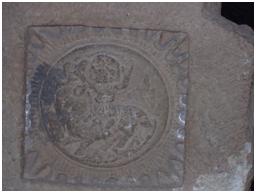
Figure 2.3. Surya Majapahit, Sun God
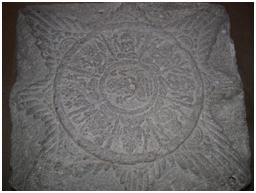
Figure 2.4. Surya Majapahit, God Shiva
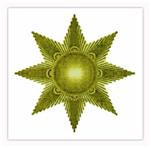
Figure 2.5. Surya Majapahit, basic
2.3. Writing
Prasasti from Majapahit used old Javanese writing (tulisan Jawa Kuno).
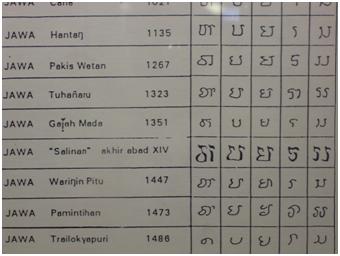
Figure 2.6. Old Javanese writing

Figure 2.7. Prasasti
3. Buildings
3.1. Palace
In the history novel Gajah Mada, it was said that the palace of Majapahit during Jayanegara’s reign was called Tatag Rambat Bale Manguntur. The capital of Majapahit was in Trowulan, Mojokerto, East Java.
Majapahit palace perhaps looks like a candi (temple). Below is the poster of a candi that can be used as a reference.
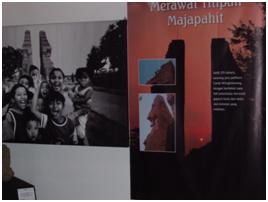
Figure 3.1. Poster of Candi Wringinlawang
Gapura (gates) of Candi Wringinlawang, as seen in the poster, was a gapura of bentar type, that is, gapura without roofs. This gapura was the outer gates of the temple complex and other buildings. Gapura bentar originated in the Majapahit period. As such, this gapura can be used to indicate the palace complex of Majapahit.
The following is the entrance to the old complex of National Museum in Jakarta as well as miniature of candi. These can perhaps be used as inspirations as well for the palace.
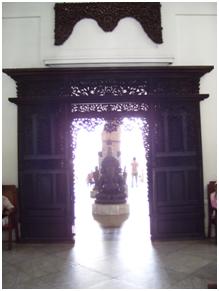
Figure 3.2. Entrance to Museum Nasional, old building
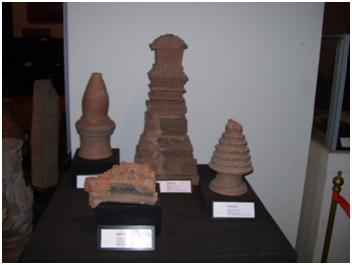
Figure 3.3. Miniature of Candi
3.2. Houses
There were not much ruins or research on the houses of the people in the Majapahit era. However, there were several remains of houses that can be used as a reference. The following is the reconstruction of houses as presented in the National Museum, Jakarta, Indonesia.
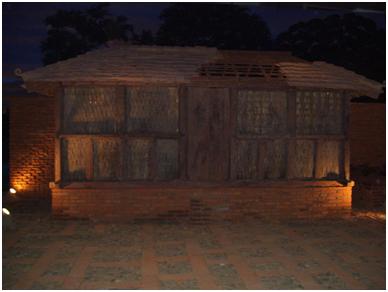
Figure 3.4. House in Majapahit.
3.3. Pillars
The following are miniatures of pillars in Majapahit. It is not clear if these are pillars of palaces or houses.
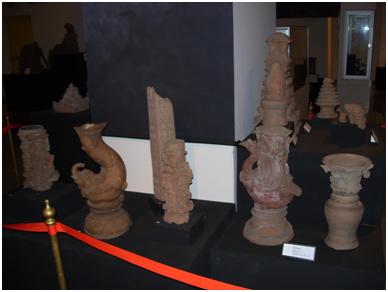
Figure 3.5. Pillars in Majapahit time
4. Clothes & Accessories
The following are the information regarding the clothing during Majapahit time that were gathered from examining arca and old accessories in National Museum in Jakarta, and do not guarantee that this type of clothing is what was really used by the people and royalties in the time of Majapahit. It seems that some of the aspects of the Javanese traditional clothes bear resemblance to the clothing worn during Majapahit time. The accessories presented in the National Museum were usually made of gold or its mixture. Because visitors were not allowed to take pictures in the Gold gallery, the pictures of accessories here were the writer’s own drawing based on what the writer saw in the museum.
4.1. Hair Arrangement
Majapahit women often arrange their hair by creating a bun on the side with several strands of hair hanging on the forehead. This can be seen from the following pictures.
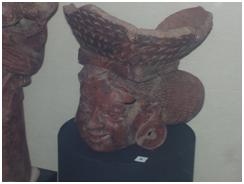
Figure 4.1. Woman’s head, left
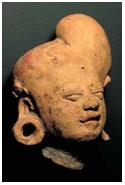
Figure 4.2. Women’s head, right
4.2. Clothing
There are two sources for Majapahit clothing that is presented here; they are the arca (statues) and figurines. The clothing of Majapahit that can be seen from the figurines of royal females, shown in the following picture, shows that the noble women at that time wore clothing that is not much different from that worn by Javanese princess now. They use kemben (a strap of fabric worn around the chest and waist) and fabric to cover the legs.
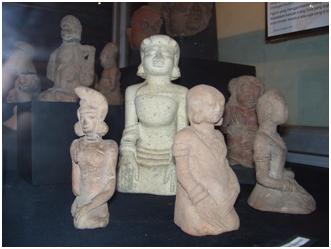
Figure 4.3. Figurines of noble women
Other sources that can be used to infer the Majapahit clothing was from their statues. The statues from the Majapahit era are usually the statues of gods and goddesses or rulers. Their clothing is the clothing of the Ksatria caste (the ruler caste). It seems that because Majapahit was a Hindu kingdom, there was also a caste system in the kingdom and it is likely that each caste has its own style of clothing.
Although arca is a good source to infer the Majapahit clothing in that time, or at least the clothing of the royal family and nobles, but one thing to take note is that, arca is often a form of hyperbole of exaggerated beauties. For example, it is likely that the women at that time were not bare-chested although the statues of Dewi Suhita and Tribuwanatunggadewi did not wear chest covering. As such, it is difficult to determine how far can this statue be used as a reference for Majapahit clothing.
This difficulty is added because the rulers at that time were often equalized as gods and goddesses such that often the statues were named with gods’ and goddesses’ names. For example, the arca of a goddess is said to be the arca of Tribuwanatunggadewi because the queen was thought of as the reincarnation of that goddess. As such, one needs to question if the clothing depicted by the arca is truly the reflection of the clothing of the kings and queens at that time or is it merely the people’s imagination of the clothing of gods and goddesses.
However, the accessories found in the ruins of Majapahit or other eras seem to indicate that the accessories that were used by the statues are really the accessories worn by the people at that time (people meaning the nobles because there was not much information regarding the clothing and accessories of ordinary people at that time), although the accessories on the arca look more complicated and beautiful. Hence, it is likely that the clothing or the clothing style that are depicted by the arca reflect the real clothing for that time.
The following are the women statues that can be used as a reference of queen’s clothing. However, it cannot be concluded if this clothing is also the clothing of a female royalty.
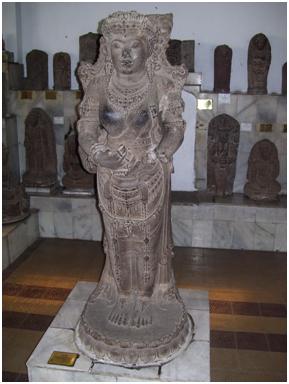
Figure 4.4. Arca of Dewi Suhita
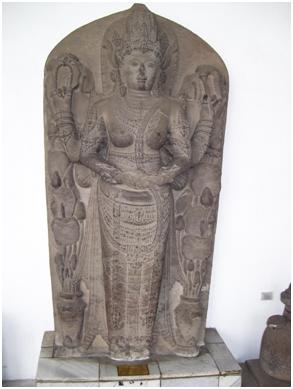
Figure 4.5. Arca of Tribuwanatunggadewi
The following are the arca of the men. They are either rulers or gods; hence, it cannot be determined if this is also the clothing of the male royalty too.
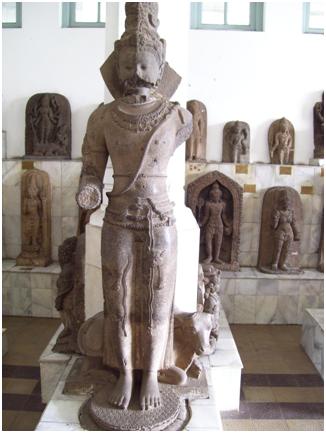
Figure 4.6. Arca of man 1
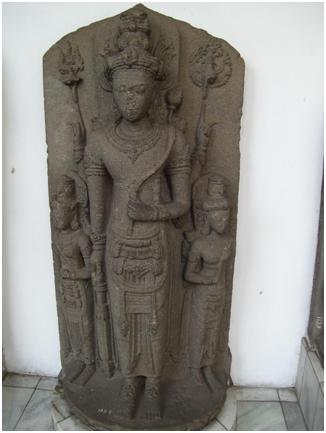
Figure 4.7. Arca of man 2
The National Museum in Jakarta presented several figurines of commoners. However, the figurines were almost unrecognizable. What can be noted from the figurines was that the commoners were bare-chested and wore a piece of cloth from waist down.
4.3. Fabric
The fabric used is probably batik. It was said that since the 10th century, fabrics with patterns were introduced by traders from India and China. Batiking itself was said to have been known since the Majapahit era. Majapahit batik at that time can be traced to Mojokerto and Tulung Agung. However, the batik in Mojokerto and Tulung Agung now have been influenced by batik pattern from Solo and Yogyakarta because of the rapid spread in the region. Batik also had external influence, such as China. AS such, does the Javanese batik we know today represent the Majapahit batik, we do not know. However, it seems that it is fine to use the batik we know today to depict the clothing of Majapahit people.
Batik itself was started to be used in the keraton (palace) by the royal families and their followers. However, its use eventually spread outside. As such, batik can be used to depict the clothing of royalties and commoners.
4.4. Ring
Ring is used by the royal families or nobles, be it by men or women. The ring is usually worn around the thumb or little finger. However, from looking at several statues, the ring is often used not around the little finger but the forefinger.

Figure 4.8. Various rings (as seen in the National Museum, Jakarta)
4.5. Earrings
The earrings used by the statues are usually earrings with intricate designs. However, the earring used by the figurines or the women’s heads statues (Figure 4.1., 4.2., and 4.3.) do not have intricate design. One characteristic that all the earrings shared is that they are all quite big.

Figure 4.9. Earring (as seen in the figurine and women’s heads statue in National Museum, Jakarta)
4.6. Necklace
The heads (or bandul) used for the necklace vary. The following are the drawings of the necklaces as seen in the National Museum, Jakarta.

Figure 4.10. Necklace with bean heads

Figure 4.11. Necklace with catfish heads

Figure 4.12. Necklace with shell heads
4.7. Caste Band
Caste band, or in Sanskrit language called Upawita, is usually used by people from the Ksatria (caste of warriors and rulers) or Brahma (caste of priests) castes. Upawita shows their status. Upawita is usually used across the chest or on the left shoulder. Upawita has a bandul (head) that is usually in the form of cocoon.
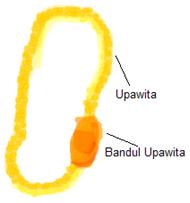
Figure 4.13. Upawita (as seen in the National Museum, Jakarta)
4.8. Bracelet
Bracelet is used by men and women, and is usually quite wide.

Figure 4.14. Bracelet (as seen in the National Museum, Jakarta)
4.9. Armband
Armband, or keyura, is used on the upper arm and is facing to the side or to the front.

Figure 4.15. Armband (as seen in the National Museum, Jakarta)
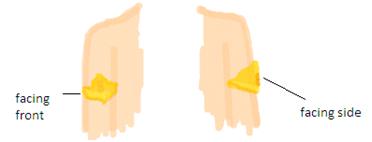
Figure 4.16. Using the armband on the upper arm
4.10. Waistband
Waistbands for noble men and women are different. Men’s waistband, or udharabandhi, has a wide front with gold surface and bronze mixed with clay on the inside, and it is tied with a rope. Women’s waistband, or pending, is made from thin gold.
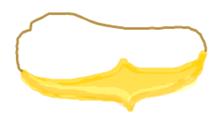
Figure 4.17. Men’s waistband (as seen in the National Museum, Jakarta)

Figure 4.18. Women’s waistband (as seen in the National Museum, Jakarta)
4.11. Chest Accessory
Chest accessory used is crescent-shaped, tied with a rope.
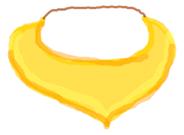
Figure 4.19. Chest accessory (as seen in the National Museum, Jakarta)
4.12. Keris
Keris, a type of blade, was used in Majapahit, as seen in several statues where keris is carved at the back of the statue. There are many types of keris, that are different according to the use, status of bearer, origin, etc. For example, a source said that it is unlikely that Dyah Pitaloka, a Sundanese princess to be wed to Hayam Wuruk, to carry a kujang because women at that time usually carried a smaller keris called cundrit.
4.13. Overall Picture
The following is the overall picture of the accessories as seen in an arca:

– End of Paper –
recently i found your website and i concern a lot about singasari epic .
source of singasari epic was negarakertagama books which released several hundred years after singasari kingdom is dissapear.there are many pro and cons about singasari kingdom like what mr slamet mulyono explained in book negara kertagama……..
for your info i come from trowulan ,the centre of mojopahit city in past time
and if you need more info about mojopahit kingdom or javanese story ,you can reach me at my email below.
Darma
very well-written infos about majapahit.
lets hope, pray and work hard so that we can somewhat restore the golden age of majapahit for our beloved indonesia.
really looking forward to talk/chat with you.
salam
-dana-
hi, dana, thanks! put quite an effort for this report =p.
Thank you, Make this website. was very well. I’m very need this information for history lesson in my school…. Thank you one more again………
HI……. I’m student of Rasuna Said class in Al Irsyad Junior High School. I like this website. Wow!!! Good website……. Important website. I’m very need this chapter and information. Thank’s for you make this website. I like this!!!
thanks, dhani, n the student from rasuna said. I wanted to share this so that ppl will know more about the great kingdom majapahit =p. btw, orang indo kan yah? komentar indo ajah lagi =p
dear mentari, fyi menurutku banyak sekali yang para ahli sejarah lupakan datanya(dan aku bukan berarti mengklaim aku lebih baik dari mereka ya), kalau kita lihat genealogy menurutku ada yg terlewat, yaitu spt masa pemerintahan Kertarajasa kok langsung ke Jayanegara, kalau aku perhatikan sebelum itu berpindah seharusnya dipegang oleh Rajapadmi dahulu(berdasar analisa data arca), selain itu kok naive sekali bahwa kata Majapahit di hubungkan begitu saja dengan buah maja yg berasa pahit, padahal sastra tentunya tidak akan mentah2 begitu saja dalam menamai sebuah tempat apalagi sebuah kerajaan besar spt Majapahit.
wah iya neh, aku juga cuma liat2 dari beberapa buku aja pas bikin ini, n ini juga simple riset buat bikin drama anak sekolahan. jadi maklumlah kurang baik hasilnya. sebenernya kalo dari yg aku baca, nama kerajaan Majapahit di prasasti itu bukan Majapahit. itu sepertinya sebutan yg baru muncul nanti2nya.
wah kalo anda punya info soal majapahit, boleh tuh nulis2 juga, apalagi bahasa inggris. yg prompt aku buat bikin ini pake bahasa inggris (aslinya catatan yg aku bikin itu bahasa indo) karena minimnya info soal majapahit dalam bahasa inggris yg lumayan lengkap (yah ini jg ga lengkap sih =p). jadi berharap ini entry bisa ngebantu orang2 luar yg mau cari info soal majapahit 😀 (walau mungkin yg ngunjungin neh blog dikit hihihihi)
seram……………….
Do you have more pictures of figure 4.4? Specifically a higher resolution one of the front and from the back where the figure is transforming into lotus leaves? It would be very helpful. As it is, your site is the only image of it I could find on the web which is pretty amazing.
Hmm.. I just noticed that wordpress seriously reduced the pixels of my pictures! I have a higher res pic of this, if you can kindly give me your email address, I’ll send it to you. Btw, the figure does not transform into lotus leaf. I don’t get what you meant by that.
Hey thx, finallyi got what i need for my Indonesian History assignment! tapi sy msh butuh keterangan dari gambar figure 4.4 Dewi Suhita. koq ga ada yah kyk yg lain2 keterangannya? hehe makasih banyak sebelumnya.. 🙂
Last time I visited Yogjakarta, Central Java in Indonesia, we passed by a king’s compound, We get off from the car wanting to take a photo in front of the place yet it happened that there were people near the gate who were watching what we were doing so we asked permission if we can see inside and they let us in with the warning that we can’t get too close to the palace and the other structures inside the place. We agreed and took pictures. One of the interesting photo I took was of the fruit called “maja” which my Indonesia friends said is actually the fruit where the name “Majapaahit” is derived. This is the reason why I tumbled into this blog. What is written here is very helpful when it comes to what Majapahit kingdom is all about. Thank you.
Last time I visited Yogjakarta, Central Java in Indonesia, we passed by a king’s compound, We get off from the car wanting to take a photo in front of the place yet it happened that there were people near the gate who were watching what we were doing so we asked permission if we can see inside and they let us in with the warning that we can’t get too close to the palace and the other structures inside the place. We agreed and took pictures. One of the interesting photo I took was of the fruit called “maja” which my Indonesia friends said is actually the fruit where the name “Majapaahit” is derived. This is the reason why I tumbled into this blog. What is written here is very helpful when it comes to what Majapahit kingdom is all about. Thank you.
Reply
It is a pity that the Pajajaran Kingdoms of West Java do not get as much attention little in Indonesian history. The Pajajaran Kindoms were almost 1000yrs older than Majapahit Kingdom. Incidently, wasn’t the first Raja of Majapahit a Pajajaran Prince? I believe there is more wonderful history to research and write about in Indonesia than any other country in the world. Thank you for your research.